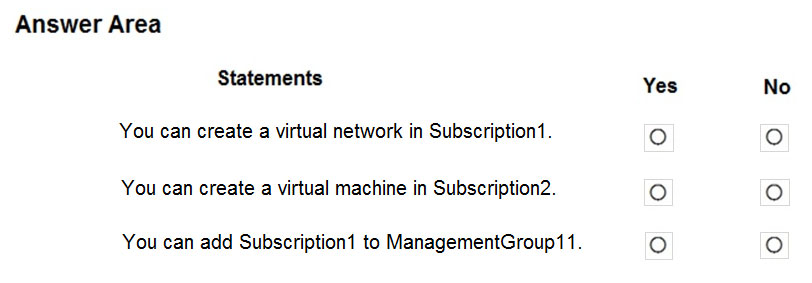

HOTSPOT -
You have the Azure management groups shown in the following table:
You add Azure subscriptions to the management groups as shown in the following table:
You create the Azure policies shown in the following table:
For each of the following statements, select Yes if the statement is true. Otherwise, select No.
NOTE: Each correct selection is worth one point.
Hot Area:

fedztedz
Highly Voted 4 years, 7 months agoKirintas
4 months, 1 week agoDurden871
2 years, 4 months agoavidlearner
1 year, 11 months agoRuzhdi
1 year, 3 months agoalexn76
2 years, 3 months agoKrisJin
2 years, 2 months agoAlcpt
2 months agoggogel
1 year, 7 months agoZemar
2 years, 3 months agotita_tovenaar
4 years agotita_tovenaar
4 years agopieronegri
4 years, 7 months agomlantonis
Highly Voted 9 months, 3 weeks agovrm1358
6 months agoElDakhli
2 years, 6 months agoHarssh
3 years, 7 months agoHarssh
3 years, 7 months agoSumanSaurabh
2 years, 7 months agojoergsi
3 years, 6 months agokilowd
3 years, 1 month agoxavigo
3 years, 2 months agoAzghouls
Most Recent 4 days, 15 hours agoMasterMans
6 days, 11 hours agosaadraaz
2 months, 3 weeks agoPonpon3185
4 months, 2 weeks agoDankho
8 months, 3 weeks agoNickyDee
9 months, 3 weeks agoPenagache
4 years, 6 months agooooMooo
4 years, 6 months agoBruce_dB
4 years, 5 months agoshnz03
4 years, 1 month agoAubinBakana
9 months, 3 weeks agoChiboy
9 months, 3 weeks agoFrost312321
9 months, 3 weeks agoyana_b
9 months, 3 weeks agolewisjcsc300
10 months, 1 week agoTheFivePips
11 months, 2 weeks agoTheFivePips
11 months, 2 weeks agoamurp35
1 year ago23169fd
1 year, 1 month agoCharumathi
1 year, 1 month ago